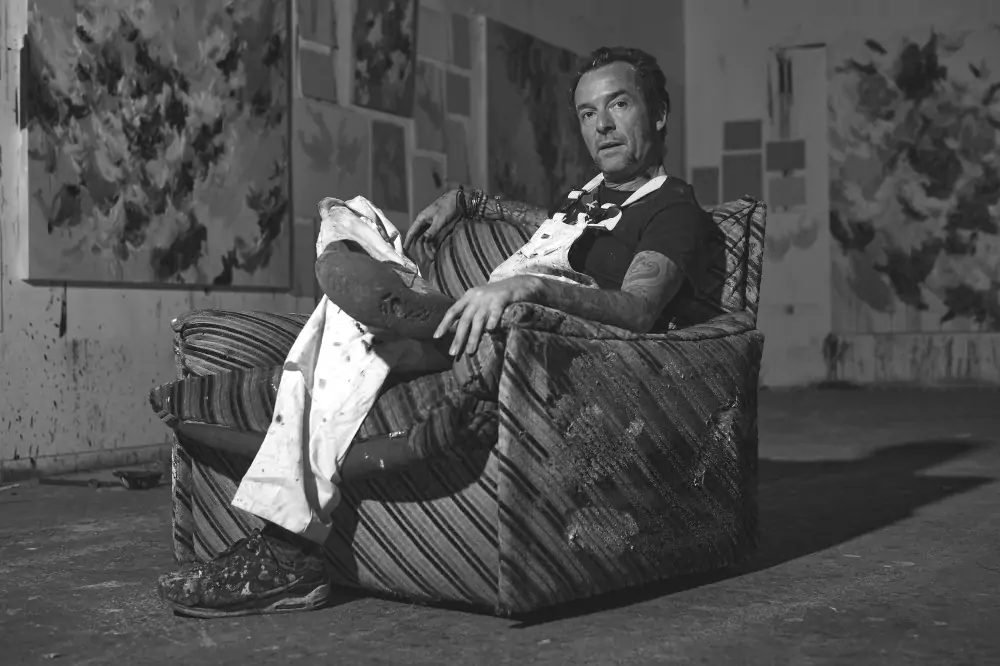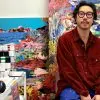With creative audacity and a rebellious spirit, multidisciplinary Belgian artist Arne Quinze seeks to penetrate the suffocating confines of what he terms our ‘Four-Walled Religion.’ Through his thought-provoking works, Quinze aims to dismantle these metaphorical barricades, inviting us to rediscover the richness and beauty of Mother Nature beyond our modern, insular way of life. Quinze’s work is a rallying call, urging us to break free and revel in nature‘s wonders.
Born in 1971 in Belgium, Quinze currently lives and works in Sint-Martens-Latem, a town near the Belgian city of Ghent. Since his nascent days as a graffiti artist in the 1980s, he has questioned the role of our cities, searching for ways to turn them into open-air museums. This dichotomy reflects his desire to escape the disheartening cityscape. Graffiti became his lifeline at the time, as he strove to maintain his creativity and existence within the stifling, oppressive grey monotony, rebelling against rigid, colourless edifices and transforming them into a lively canvas.

Image courtesy of the artist
In my work, I am exploring human interaction and the impact of urbanization on nature, reflecting on our estrangement from our roots
Arne Quinze
As Quinze continued to sharpen his craft, he evolved from graffiti to the immersive world of three-dimensional sculpture, driven by a passion for agency, social engagement, and meaningful impact. His journey was not without its critics. One of Quinze’s most notable pieces, “The Sequence,” is a monumental installation in Brussels. This sprawling, bridge-like structure of interwoven wooden planks symbolizes the connection between people and institutions.
At the heart of Quinze’s practice is his wildflower garden, a sanctuary and muse to Quinze, yet also a critical piece in the puzzle of his creative process. In his approach, we witness Quinze embodying the spirited energy of the nature he strives to reconnect us with. Quinze states he is “no eco-warrior”; he is an artist mesmerized by nature’s equilibrium of power and fragility, contrasting sharply with the stark realities of human society.
His latest exhibition at MARUANI MERCIER, ‘The Forbidden Paradise,’ explores the preservation of nature through documentation. It reveals deeper layers, extending our gaze beyond the earthly realm into a broader universe. Additionally, Quinze’s recent exhibition “Are We The Aliens_” in Venice, a collaboration with award-winning music producer Swizz Beatz, continues this exploration.
Quinze thrives on the tension between chaos and order, producing harmonious works that are visually arresting and conceptually rich, where explorative expression collides with the unpredictable flow of human activity. Spanning multiple mediums and materials, from oil paints and organic forms to industrial materials, Quinze has created many epic projects. Notable among these are ‘Uchronia,’ a large sculpture at the Burning Man festival in Nevada in 2006, and ‘The Visitor,’ a striking installation in Beirut, Lebanon, in 2009. We caught up with Quinze to learn more about his practice, his sources of inspiration, and more.
Hi Arnie, How are you doing? Thank you for taking the time to speak with us. Could you please introduce yourself to those who may not know you or who might not be familiar with your work?
Arne Quinze: Growing up in Belgium, my artistic journey began amidst unspoiled natural landscapes, which has profoundly shaped my vision. In my work, I am exploring human interaction and the impact of urbanization on nature, reflecting on our estrangement from our roots. My wildflower garden is an essential part of my practice – it is both a sanctuary and a muse, inspiring my oil paintings and sculptures. I seek to capture nature’s delicate balance of power and fragility, embodying the Japanese concept of “Mono No Aware.”

200×400 cm
Image courtesy of the artist and MARUANI MERCIER
Could you share with us the early moments of your journey into the arts, including how you transitioned from being a graffiti artist to creating large-scale installations and what motivated you to embrace a career as an artist?
Arne Quinze: I grew up in a rural home surrounded by a beautiful garden. At age 9, my family moved to Brussels, where the urban monotony was in stark contrast with my love for nature. In rebellion, I turned to street art to add colour to the city. Inspired by the obscure vibes of the ‘80s experimental electronic music, the art scene, and Manga Anime culture, I began merging the new digital era’s energy with nature’s diversity, actively aiming to transform urban spaces into vibrant, diverse canvases.
Your practice is multifaceted, encompassing various mediums, from sculptures to drawings and paintings. Yet, you are well-known for your sculptures, which often incorporate wooden planks and recycled materials. Can we delve into your practice, inspiration, and the themes you explore, such as social interaction and urban environments?
Arne Quinze: For me, the medium doesn’t matter as much. I employ various disciplines, from traditional painting to spatial sculptures in ceramics and aluminum, glass sculptures, to video creation and the exploration of AI. Wood, however, I no longer use. It was a material I employed for a while with the sole purpose of introducing the aspect of transience.
All mediums serve the purpose of conveying my narrative — a narrative that delves into why we, as humans, have become so alienated from our natural origins. My storytelling is rooted in researching what we have lost, looking back into nature and its diverse spectrum. I am constantly in awe of nature; I simply open my eyes and observe, whether it’s the flower blooming in my garden or mesmerising sunsets. I invite people to join me in rediscovering nature because I truly believe that many of our current human problems can find solutions by reconnecting with nature. We are the only species on this Earth that takes without giving back. This imbalance must end; we must find harmony with nature once again.
Environmental themes are evident in many of your works. How do you address environmental issues through your art, and what role do you think artists should play in advocating for environmental sustainability?
Arne Quinze: I’m not an eco-warrior; I’m an artist. It’s quite simple: I look to nature and see its beautiful diversity, witnessing the delicate interplay between power and fragility. Yet, when I glance around at human society, I see the opposite. I grapple daily with humanity’s dual nature, recognizing our tendency to exploit nature while retreating behind the four walls of modern existence.
From cradle to grave, it feels as though we’re confined by a ‘Four Walls Religion’—born within the sterile white walls of hospitals, educated within the enclosed boundaries of classrooms, confined by the concrete barriers of offices, enclosed within the brick walls of our homes, and ultimately laid to rest within the four walls of our coffins. In essence, my art seeks to challenge these confines, to break free from the monotony and alienation they foster, and to reconnect us with the vibrant, diverse beauty of nature.
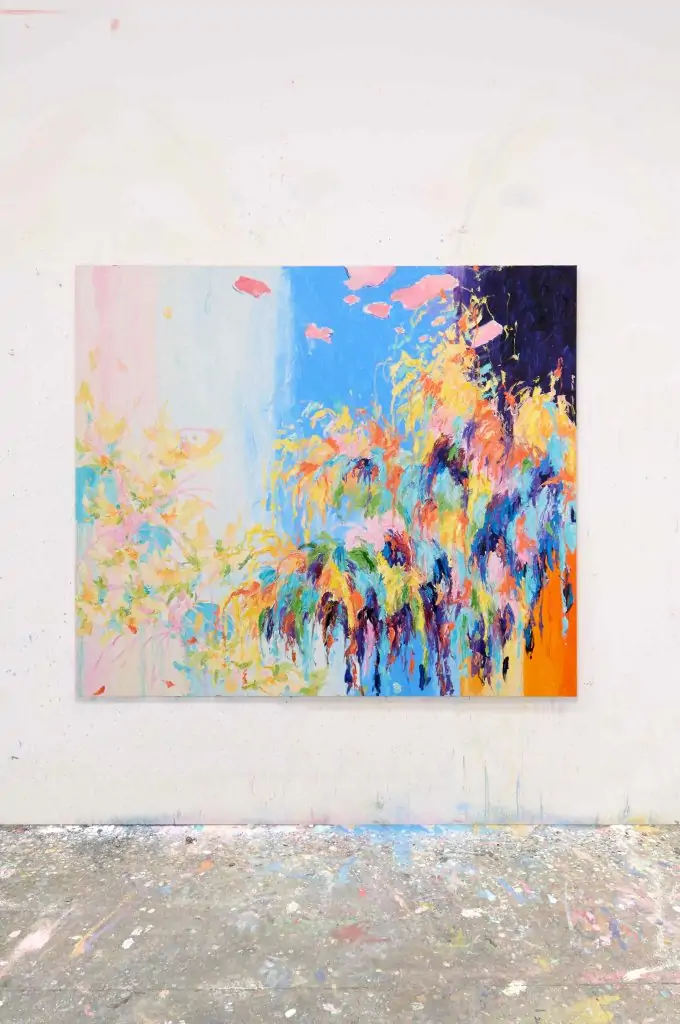
185×215 cm
Image courtesy of the artist and MARUANI MERCIER
Building on that, how has your background in graffiti influenced the conceptual and aesthetic aspects of your public installations?
Arne Quinze: Escaping the reality of a disappointing cityscape, graffiti painting became my lifeline. The once-promising city of my childhood revealed itself as a monotonous grey mass governed by outdated rules, leaving me suffocated within its gloomy walls.
The relentless uniformity of the city fueled my defiance. I couldn’t fathom how people existed in identical rabbit hutches devoid of creativity or vitality. Thus, I embarked on a mission to inject colour and provoke reaction through graffiti, often venturing into illegal territories. One memorable project involved transforming an entire train during the inauguration of a new metro station, eliciting a range of reactions from disgust to admiration. That moment ignited my passion to awaken the city from its lethargy.
Determined to infuse cities with vibrancy, I embarked on a journey of self-discovery and collaboration, working alongside renowned graffiti artists in Amsterdam and immersing myself in the electric hues and bold shapes of the 1980s. As my artistic evolution progressed, I transitioned from 2D graffiti to 3D sculptural works, driven by a desire for social interaction and meaningful impact.
The transition wasn’t seamless – my early commissions often met resistance and criticism. However, these setbacks fueled my determination to create meaningful change. I decided to step away from illegal interventions, and sought partnerships and legitimacy, advocating for my vision of urban transformation.
Despite initial scepticism, perseverance paid off. By constructing works in three dimensions and engaging with municipal authorities, I began to shape urban landscapes in a more organised and impactful manner. Each challenge, each rejection, fuelled my resolve to redefine urban spaces and invite viewers into my immersive universe.
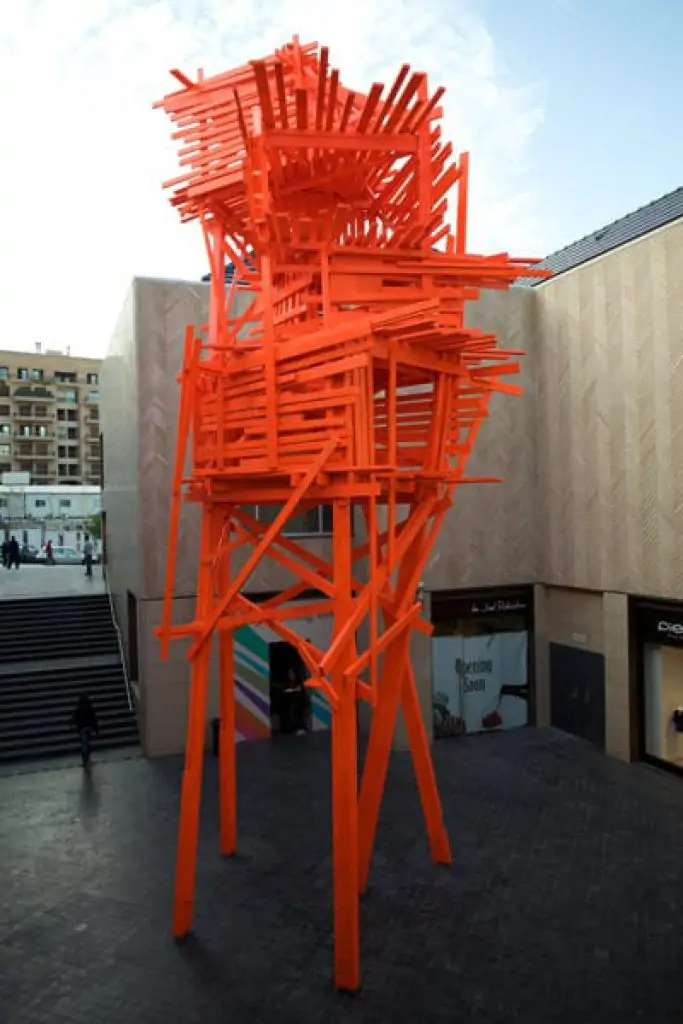
Beirut, Lebanon
Image courtesy of the artist
Your installations often become landmarks within their locales. How do you consider a location’s cultural and social context when planning and constructing your installations and sculptures?
Arne Quinze: For my public interventions, I prioritize a thorough understanding of the environment in which I work. My creative process begins with meticulous exploration of the cultural and demographic milieu that surrounds the project. Collaborating closely with my team, we delve into extensive research of the cultural context and physical environment before embarking on the creation of the artwork. I firmly believe that a public intervention must engage in a meaningful dialogue with its surroundings. Therefore, conducting in-depth studies of the context is paramount.
By immersing ourselves in the unique characteristics and nuances of the environment, we ensure that our work not only harmonizes with its surroundings but also contributes to and enriches the cultural fabric of the community it inhabits.
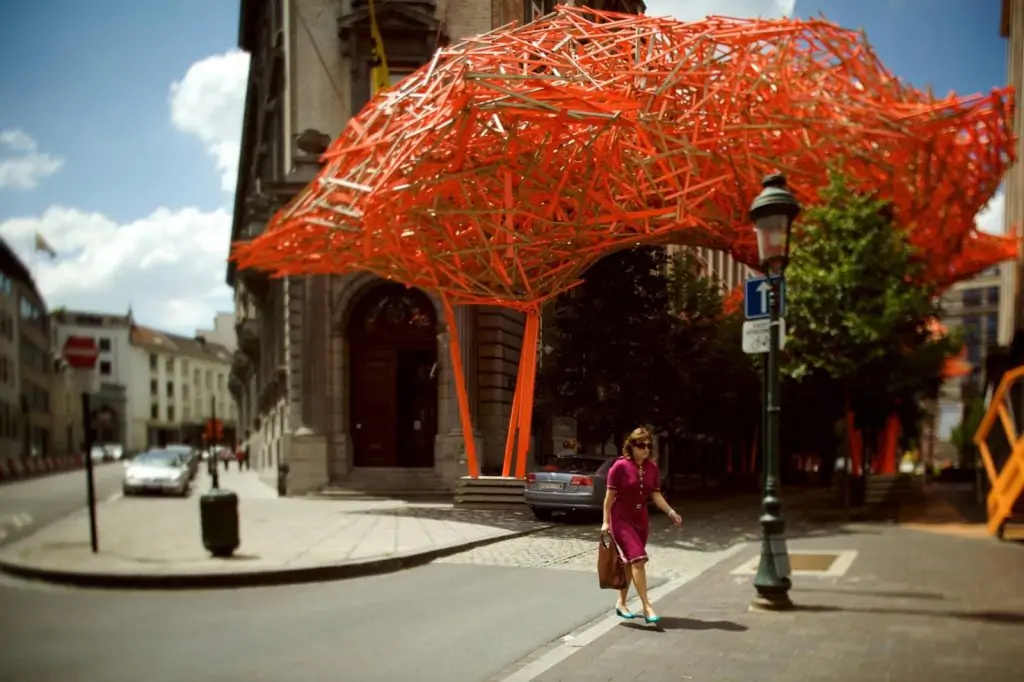
Public wooden installation — Brussels, Belgium
Image courtesy of the artist
Your latest exhibition at MARUANI MERCIER, ‘The Forbidden Paradise,’ delves into the concept of preserving nature through documentation. It unveils deeper layers that extend our gaze beyond our earthly realm and into a broader universe. Can you tell us more about the works in the exhibition and its essence?
Arne Quinze: It’s not merely about painting pretty flowers; it’s about unveiling the raw essence of life and its profound significance in the cosmos. I strive to capture the intricate interplay between strength and vulnerability, the very forces that have engendered the astonishing diversity surrounding us. Consider me an archivist of sorts entrusted with the task of safeguarding this diversity.
In my recent works, I’ve expanded the scope beyond a terrestrial lens to include alien celestial phenomena such as meteor showers and distant galaxies. By investigating a cosmic narrative, I seek to underscore the extraordinary rarity of life in the universe, shedding light on the alien facets of human nature capable of disrupting Earth’s delicate equilibrium.

Photography by Dave Bruel for Arne Quinze.
Image courtesy of the artist
In addition, you recently collaborated with the award-winning music producer Swizz Beatz on the ‘Are We The Aliens_?’ exhibition, which opened at the historic 16th-century Scuola San Pasquale, Campo San Francesco church in Venice. This exhibition fuses sonic soundscapes with sculpture. Can you tell us more about the essence of the exhibition, how the collaboration came about, and what it was like working with Swizz Beatz?
Arne Quinze: In ‘Are We The Aliens_,’ I wanted to challenge the notion of our human presence on Earth. As we increasingly detach ourselves from nature, this exhibition prompts us to consider whether we are, in fact, the true aliens on this planet.
Through six distinct works, I delve into our human impact on Earth. I question our species’ role, vividly portraying it in pieces like ‘Impact Glass_‘ and ‘Six Testimonials_,’ which depict the arrival of our alien-human DNA on Earth and its evolutionary transition from biological to digital forms.
I grapple daily with humanity’s dual nature. Recognizing our tendency to exploit nature and retreat behind the four walls of modern existence, I take on the daily role of being a gardener, functioning as a protector of nature and nurturing my large wildflower garden around my atelier. I strive to research and capture the splendor of unspoiled nature in works like ‘Sonic Levitation_‘ and ‘Murchison Garden_,’ seeking to preserve nature’s unbridled diversity.

Photography by Dave Bruel for Arne Quinze.
Image courtesy of the artist
Swizz Beatz and I share a deep reverence for the natural world. ‘Sonic Levitation_‘ is an immersive installation that delves into nature’s boundless, diverse architecture. From the outset, we were captivated by the essence of this project. Our objective was clear: to craft an immersive sculpture that captures the pure essence of nature’s awe-inspiring beauty. Despite our diverse backgrounds, our fundamental goals align — to bring forth beauty and share the unique grandeur of life.
Striving to reshape urban landscapes and cultivate a harmonious dialogue with nature, artworks like ‘Ceramorphia_‘ and ‘Bronze_‘ signify nature’s resurgence. As vibrant sprouts reclaim urban spaces amidst concrete jungles, my works set out to represent a return to nature’s harmony—a journey towards equilibrium between humans and nature.

Photography by Dave Bruel for Arne Quinze.
Image courtesy of the artist
Looking ahead, are there specific social or cultural issues or artistic methods you are particularly eager to explore? If, so, how do you see these themes evolving in your future projects?
Arne Quinze: There is still so much to do and stories that I want to tell. As I always say, it’s only the beginning. I’m currently working on several major public installations in South America and Asia, where I aim to push even further with the immersive light and soundscape sculptures that I develop.
Right now, I’m fully focused on my solo painting show. My upcoming solo show, ‘Secret Beauty,’ will be on view from September 22 to November 24, 2024, at the Ludwig Museum in Koblenz, Germany. The show will feature a projection of my urban projects in conversation with a series of large-scale oil paintings.
Can we discuss your legacy? As an artist whose practice has impacted society at a cultural and social level, how would you like to be remembered?
Arne Quinze: I aspire to be remembered as a gardener whose passion and dedication inspired to rediscover and reconnect with the boundless diversity and majestic splendour of the natural world.
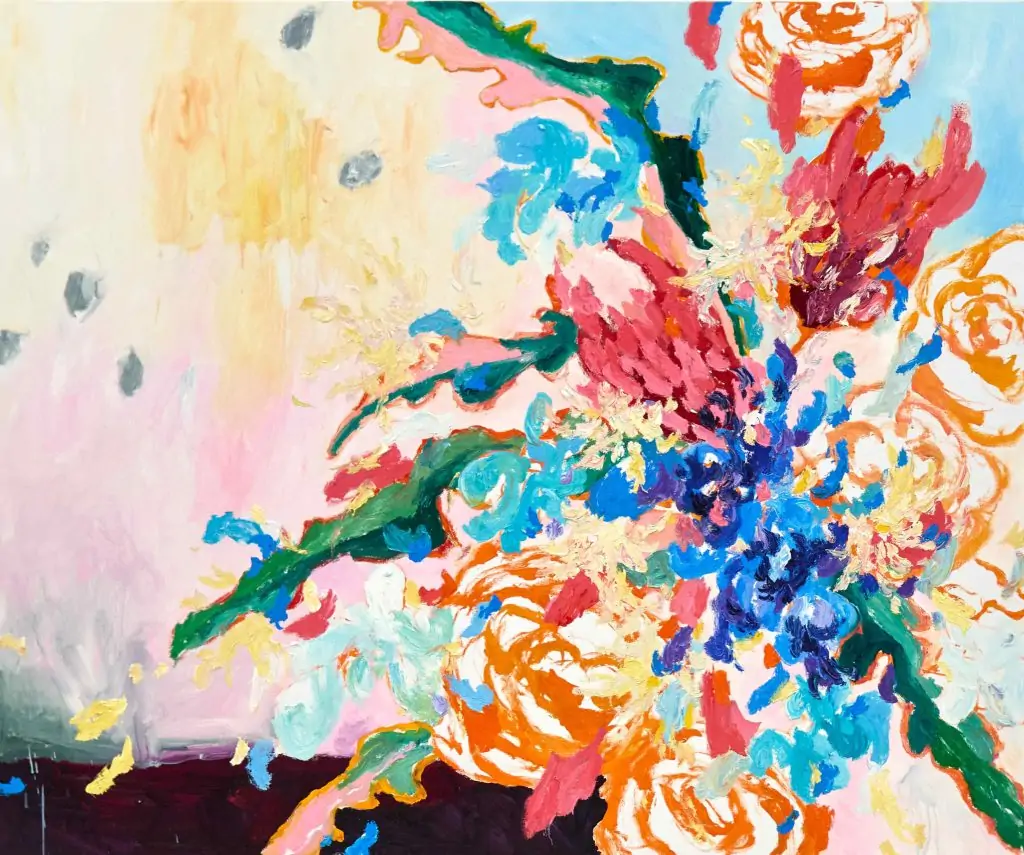
150×180
Image courtesy of the artist and MARUANI MERCIER
Finally, could you share your philosophy of art? How do you describe and understand art’s core importance in your life and career?
Arne Quinze: Art has been ingrained in my life for as far back as memory serves. Since childhood, I was driven by desire for a creative expression beyond any boundaries or rules. To me, art acts as a transformative lens, shaping my perception and interactions with the world. Through this lens, I endeavour to translate my personal experiences and insights, providing viewers of my artwork a glimpse into my interpretation of nature’s beauty.
To keep update with Arne Quinze and his work head over to his website link below
©2024 Arne Quinze


